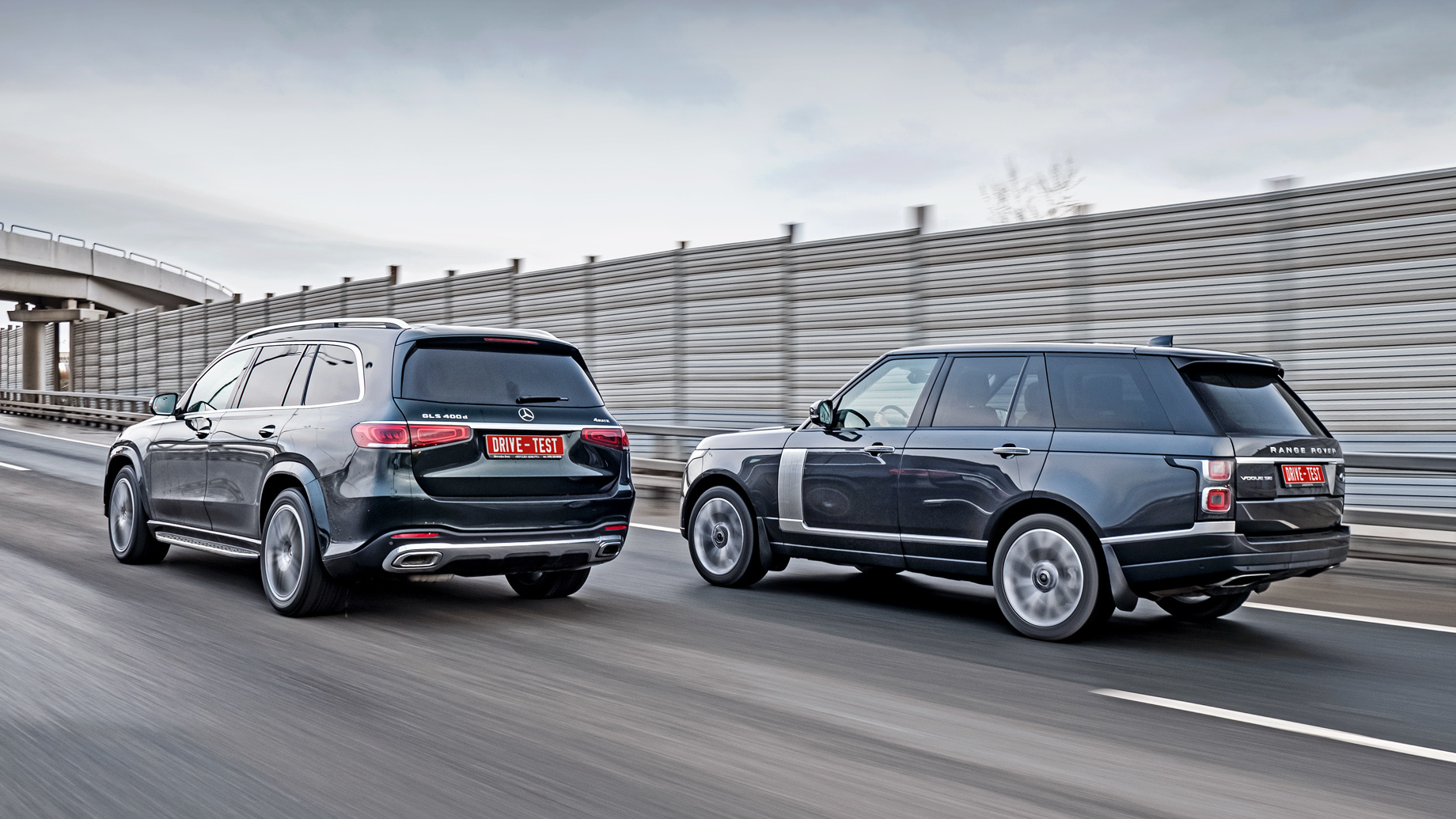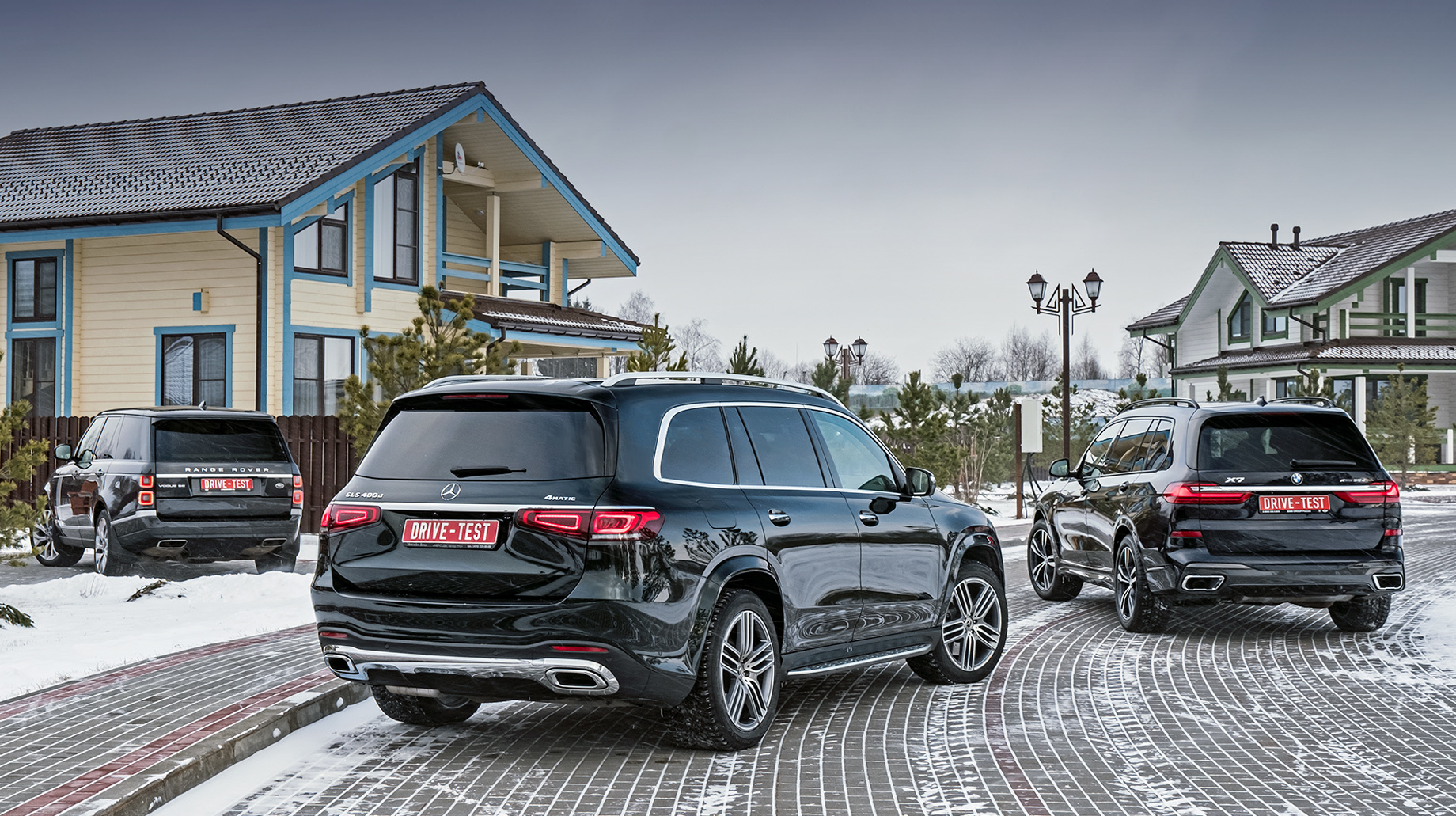The market of the largest high-status four-wheel-drive cars is traditionally diesel in our country. The share of such modifications is 85% for the BMW X7, 86% for the Mercedes GLS, and 80% for the Range Rover. The exception is the Lexus LX 450d, which is chosen only by every third buyer of the LX. It is in this sequence that the giants are located in the sales chart, if we talk about purely diesel cars. And since we initially decided that we would arrange a triple test, we leave the unfresh body-on-frame LX (we are waiting for the release of a new one soon) out of the equation. At the same time, we analyze the GLS, which we haven’t met yet, with special attention.
What’s interesting, versions with basic engines, the power of which, as a rule, is optimized for the sake of reducing the tax burden (don’t forget about the increasing coefficient for a car luxury), are in the greatest demand in this segment. For example, the GLS X166 Series was most often bought in the 249-horsepower 350 d version. Now the most affordable X167 is the GLS 400 d with a 330 hp (700 N*m) inline six-cylinder engine.

The Mercedes is perfectly packed by default, but the base X7 xDrive30d (249 hp, 620 N*m) is not much inferior in equipment, but it is cheaper. It loses mainly due to certain security systems, but the tax rate is not so burdensome. The configuration of the most democratic Range Rover TDV6 (249 hp, 600 N*m) differs from the BMW only in nuances. However, if you fill the “Briton” with options, it will be more expensive than competitors. The test car is a typical example of this.
What’s so cool about it? Firstly, a luxury rear seat row with a bunch of electric drives, an ottoman and a massive motorized armrest that separates passengers from each other. Separate second-row seats can also be ordered for the BMW (by paying extra money or choosing the Exclusive version), but they won’t be so cozy, although they should really be paid separately. It’s tested: we have had such a version.
Our Mercedes has a one-piece seat. A separate one, without additional payment, is offered exclusively in the First Class configuration. By the way, only this option allows pan-European liberties in the configurator. All others are sold with a fixed set of equipment. The BMW buyers are freer to choose equipment, but there are also positions tied to a certain performance. The Range Rover provides the greatest scope for imagination, but freedom costs a pretty penny.
Including the freedom to choose the road. Only the Vogue refers to SUVs in our classification, despite the frameless body. Here, in addition to the common air for the test participants, there is a downshift and electronic lock of two differentials. And these suspension travels! However, I’m jumping ahead of myself.. The Range Rover looks the most representative even in the rear-view mirror. You can’t confuse it with anything. The new GLS in general looks pretty much like the younger GLE, although the flagship has its own grille and optics.

The BMW X7 is frighteningly recognizable thanks to the hypertrophied radiator grille and wide-set narrowed headlights. It looks good live. But I don’t understand why BMW ignores the tendency to cover sills with doors. Like in other Xs, here they are the first to get dirty when you drive on a miry road. The Mercedes has another problem: the sills are clean, but the standard footboard is smeared. It’s too narrow to be useful and just gets in the way.
The sills of the Range are always neat, which is especially valuable for people of small stature who have to literally jump into a high-placed body. It’s a little easier for the driver than for the others: he can pull himself up by grabbing the steering wheel. It is more difficult for passengers, since no grab handles are provided, and the rear door opening is also not wide enough.
If you want to use the “Briton” as a personal car with a driver, then you definitely should choose a modification with an extended by 7.8 inches centimeters wheelbase — the Range Rover LWB, which is more expensive. Our short car is cramped at the knees in the back, and you can’t really put your feet in winter shoes under the front seats. Although, of course, there is a large margin over the heads of passengers. And in itself, the seat here is the softest in the trinity.
You won’t see the third row of seats in the Range. The Mercedes and the BMW, on the contrary, are sold only with a back row. And the way passengers get there is similar in both “Germans”: the electric drive slowly shifts part of the seat, clearing a moderately wide passage back. In both cars, adult passengers who are slightly taller than average can easily be placed there, but in the X7, the fit seems freer. There are also more amenities. For example, the GLS also has cup holders with individual USB-C connectors, but only the X7 can boast of a separate control panel for the fifth climate zone.

The second row of the BMW with a one-piece seat is more convenient than the Mercedes one. Both are electrified. There is parity in terms of space (both are noticeably more spacious in legs than the Range), in terms of adjustment possibilities, too. But the filler in the Mercedes is too hard and tires faster on a long road. In addition, the central tunnel is larger there. However, three’s a crowd in any of the cars: cabins are wide, but cushions with backs are clearly molded for two passengers.
In a five-seat configuration, the Mercedes trunk is the most spacious. While it is slightly smaller in the BMW. The possibilities of transformation are similar: seats of the second and third rows are folded by electric drive, forming a flat floor. The Range Rover is less suitable for cargo transportation, especially with such a sophisticated rear row. It is impossible to fold it so that it turns out to be a flat platform. Loading is complicated by the folding side, forcing you to reach for deeply packed things. This problem is also familiar to the user of the X7.
The basic ergonomics of the German crossovers is good. The range of mutual adjustments of the steering wheel and seats is wide. The backrest of the optional BMW seats “breaks”, and as a result, the body receives more confident support than in the Mercedes. The soft front seats of the Range are better suited for slim drivers. I was surprised by the too intrusive side support cushions and the inability to adjust them.
But the British interior looks and feels richer than all competitors. Light wood trim adds comfort, while dark wood in the “Germans” doesn’t attract attention – as if it doesn’t exist at all. The quality of the Range leather is also better. Besides, almost the entire interior is covered with it: plastic elements need to be sought. New accessories, which appeared after the restyling, adds gloss.. The architecture of the BMW’s slightly driver-facing front panel seems pretentious, and the leather upholstery of the seats is rougher.

But the assembly culture in South Carolina is still higher than one in Alabama, where the GLS was produced: crooked seams join a material more reminiscent of leatherette. Simple understeering switches, more or less appropriate only in the A-class, don’t add expensiveness either. Silver buttons decorated with aluminum feel plastic to the touch. Is this really a Mercedes?
But the multimedia system is no worse than that of the BMW. The interface is simple, the graphics are nice. However, the GLS offers only a touchpad on a central tunnel, where a universal selector button is located in the X. But there is a sensitive “snap”, with which you can also surf the menu, on the right spoke of the steering wheel. The sensor on the left spoke controls the instrument panel. It is quite convenient to use them without removing your hands from the steering wheel. Although sometimes there is an undesirable change of tabs when rotating.
The Range infotainment system is now unified with the Velar. All screens are controlled by a single processor, and two touch screens noticeably slow down. The Mercedes and the BMW don’t allow themselves to do this. The diagonal of the main touchscreen is a couple of inches smaller than that of the “Germans”, but this is annoying only when working with all-round cameras: you have to peer into what is happening on the monitor..
The GLS seems prohibitively large from the driver’s seat. You look in the inner mirror at the endless, stretching cabin and feel like a driver of a luxury resort shuttle. There is something truck-like about the demonstratively high fit of the Range and the large steering wheel. There is clearly less space here than in the Mercedes, but the Vogue is still perceived as a large and very weighty car.

The BMW is different. With dimensions comparable to the Mercedes, the X7 doesn’t seem excessively large and bulky at all. Especially on the move. You feel the dimensions no worse than in the X5. It is easy and even pleasant to maneuver in the flow. Not just to maneuver, but even to scorch! Moreover, the inline diesel six-cylinder engine contributes to this in every possible way: it obediently reacts to the accelerator, easily giving traction. But accelerating doesn’t turn out to be seamless – gear shifts are always indicated by short acceleration breaks.
Nominally, the BMW is inferior to the more powerful Mercedes by almost a second at acceleration from 0 to to 60 mph (7 seconds versus 6.3), but their subjective urban dynamics are comparable. It’s just because the GLS 400 d doesn’t go with all 330 hp. It starts somewhat lazily, and in order to achieve a return on all the money, you have to rotate the 2.9-liter diesel engine as if it were a gasoline one.
The advantage of the Mercedes is more evident when accelerating from high speeds. The nine-speed automatic transmission of Daimler’s own design seems more fussy than BMW’s eight-speed ZF 8HP gearbox. In addition, it is the X7 that shifts down faster than all (up to five at a time) during a kickdown.
The same ZF automatic transmission of the Range is configured differently: the gear change is softer and, it seems, slower than in the BMW. With a similar laden weight (according to the Voque’s passport, it is only 46 lbs heavier than the X) and similar characteristics of engines, the “Briton” lags behind both on paper and in life. The Range’s pace of acceleration is lower. With unhurried driving, the inhibited reaction at the beginning of the accelerator stroke is annoying: it is difficult to dose the effort to avoid jumping forward. While in cruising modes, its reactions are logical and quite consistent with the image of a sedate and solid car.
There is no sharpness in the responses to the relatively long steering wheel (3.1 turns between end positions), and the returning force is emphasized carelessly. So carelessly that there is almost no self-return at low speed. The Range Rover meets the command to change course with swings and, after a short pause, begins to turn.

It doesn’t frighten or even annoy, but it sets you up in a calm way. The Vogue doesn’t cause a desire to drive. Rolls reach an uncomfortable level long before the approach to the limit of the adhesion properties of tires. Moreover, nothing awaits you behind it, except understeering. And in the snow, where the Range is not averse to slip, the ContiCrossContact Winter holds poorly.
The ride smoothness is not ideal, at least because when passing large irregularities, the vibrations of unsprung masses are too distinct, and the air suspension works with transverse joints and pits with sharp edges more rigid than we would like. However, the Range Rover smooths small and medium irregularities diligently. And there is even a special joy in swaying on a gentle wave. The main thing is that the rear passengers don’t have bouts of seasickness. There have been such cases in my practice.
The smoothness of the Mercedes is not worse than that of the Range, but also not better. The attention that the GLS pays to transverse irregularities seems excessive, although in general, the chassis leaves the impression of being more self-collected. I like how it filters small irregularities and softens medium ones. Alas, it gives up on large ones, shaking the whole body.
The Mercedes calmly reacts to the non-sharp steering wheel’s turning (2.75 turns), accompanied by a linear increase in reaction force. The provocation of skidding or simply an excessively active change of course is stopped by the stabilization system at the root, intervening almost in advance. But it also struggles with the same result with the drift that occurs when going over the speed at the entrance to the turn.

The big Benz in general seems to be somehow characterless. Someone will say that this is what a family car should be. But BMW has a different opinion. Of course, the X7 is not a sports car either. But there is more life in it. The optional gaining twist rack requires only two and a quarter turns between the end positions. The reaction rate is also higher, although there is a lack of return force in the near-zero zone.
Active rear-wheel steering at speed doesn’t separate itself in any way: the BMW solidly and actively changes course on demand and willingly shifts in bundles. The development of a soft understeer in extreme modes is hindered by a more delicate stabilization system than that of the Mercedes. The only difference is that the X7 allows you to disable it.
At the same time, the X7 also surpasses competitors in ride smoothness, better damping almost all kinds of irregularities. But the BMW treats the road trifles too attentively, and transmits the itch from the microprofile to the body more actively than it should. That should also be the fault of the Bridgestone Blizzak LM001 friction tires with reinforced Run Flat sidewalls.
The engines are clearly audible in both “Germans”, but the Bavarian sounds nicer. In addition, equipped with double glazing, the X7 provides better isolation from external noise. The Range laminated glass has to restrain the aerodynamic disturbances that appear early, and the GLS is completely devoid of double-glazed windows. Fortunately, its Hakka R3 SUV with a developed tread, working much better in the snow, hums on asphalt no louder than the less toothy tires of the rivals. On dry land, all three cars slow down effectively, without forcing you to concentrate on the nuances in the operation of the brakes..

The weather has confused our plans to evaluate off-road properties. Ideally, the off-road-worthy Range Rover should set the bar for the crossovers, and let them compete with each other. Alas, the soil of the quarry we chose froze, and even the Vogue became a hostage to insufficient for the continental winter tire grip. All we can really do without risking the technique is to compare the geometry and, in part, the operation of the traction controls.
Even where the “Briton” doesn’t have a transmission advantage, it feels more confident due to the large suspension travel and shorter base. The “Germans” range of clearance changes is more modest. Their bodies rise to about the same height, but the Mercedes is let down by the largest base in the test and the foot boards hanging on the sides.
But the electronics of both crossovers struggle with the slip even more effectively than the Terrain Response II of the Range. In addition, the top-end GLS First Class can be equipped with an Offroad pack with a granny gear and a maximum ground clearance of 11,4 inches. The limit of the X7’s off-road abilities is a set of traction control modes for different types of pavement. In our case, they remained unclaimed..
Well, it seems that the market success of the BMW is not accidental. Slightly losing in terms of capacity to Mercedes, the X7 surpasses it in driving disciplines. Perhaps the quieter and smoother “Bavarian” is better suited to the role of a donor for the conditional Maybach than the actual GLS. Having lost in smoothness compared to its predecessor, Mercedes has not advanced much in other disciplines.

Being a well-balanced product, X7 is also more affordable than competitors. The 30d version motor in everyday operation is almost as good as the “400th” in terms of capabilities, while allowing you to count on a lower cost of ownership. It will be more and more difficult for Mercedes to fight for the consumer: prices have risen, configurations are fixed. Even on the Maybach, you won’t go far yet, since it is offered only in the S 600 model. And, for example, the best-selling Maybach S-Class is the basic version of the S 450.
Range Rover stands apart. Deliberate imposingness, coupled with rich and varied finishes, give a sense of chic, which, oddly enough, is lacking in the segment. It’s not a sin to overpay for chic, and then lose a lot of money on resale. After all, the British SUV depreciates catastrophically quickly. But, judging by the sales results (2713 Ranges were sold in 2019), there are not much fewer people who think in abstract categories than practitioners who choose X7 (3019 units per year) or GLS (2843).
This is a translation. You can read the original here: https://www.drive.ru/test-drive/bmw/mercedes/landrover/5e343cfaec05c4c15f000008.html

Published February 16, 2023 • 13m to read






